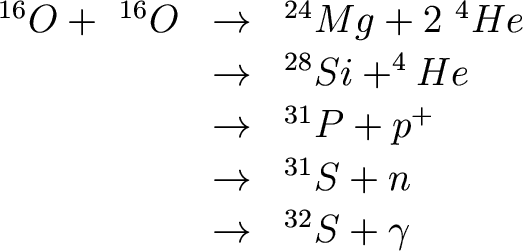
So we've made helium. Now what? For main sequence stars, now nothing. The main sequence is solely populated by stars turning hydrogen into helium.
But let's say we wanted to continue the fusion process -- can we turn helium into something else?

Two helium nuclei ("alpha particles") fuse to form unstable beryllium. If another helium nucleus can fuse with the beryllium nucleus before it decays, stable carbon is formed along with a gamma ray.
How does this depend on temperature? Around 108 K, the relationship is E3a ~ T41. A 10% increase in temperature results in a 50x increase in energy production!
At these temperatures, other reactions can also occur by the capture of more helium nuclei:

Past this, we need yet higher temperatures and densities
to do anything more. How do we get those higher temperatures and
densities?
For example, carbon burning (at 6x108 K):

and oxygen burning (at 109 K):

(Most of) these reactions create energy. If the star is massive enough, it can shine by making progressively more massive nuclei in its core. Until, that is.....
Iron
Once Iron (Fe) is made, we're stuck. Iron is the most stable of elements -- it doesn't won't undergo nuclear fusion. If a star is massive enough to create Iron, it's out of fuel. What now? All hell breaks loose. We'll see this later....